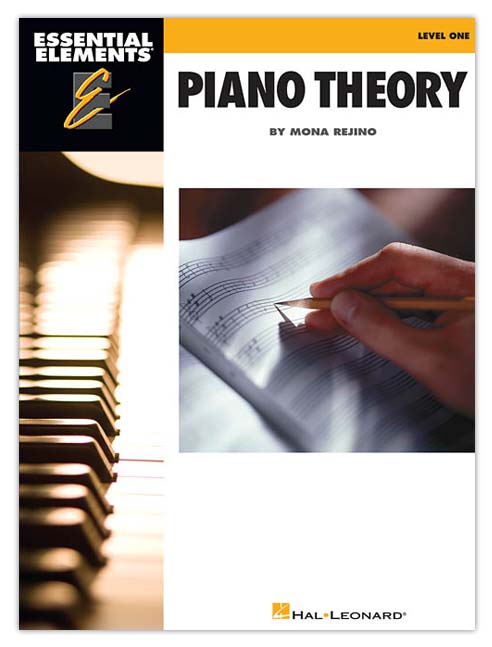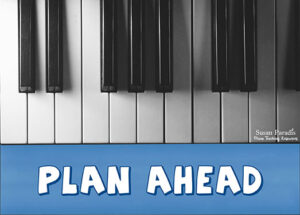Essential Elements Piano Theory by Mona Rejino
Essential Elements Piano Theory by Mona Rejino
I have attended many presentations by Mona Rejino over the years. Mona is a piano teacher as well as a composer with the music publisher Hal Leonard. Recently at the MTNA conference Mona gave me a tour of her new theory course, Essential Elements Piano Theory, and discussed her motivation in writing this series.
Mona said that when she was a student she did not understand how completing theory pages would make her a better musician. With that in mind, she set about writing a theory course with a bridge between theoretical and practical.
Each paperback book in this course is the size of a method book with about 40 pages. Level One starts at the very beginning, learning the alphabet letters on the keyboard.
My first impression is that this series is written by a piano teacher who understands what students need in beginning theory. Concepts are presented sequentially, moving right along with no busy work. The layout is clean and uncluttered. Since there are no age specific graphics on the page, it can be used with older beginners who often need to learn a lot of theory quickly. While the series is not directed at the preschool age group, music students vary widely in their abilities and the font in level one is large enough for first graders. There is even an online Teacher’s Answer Key on the Hal Leonard website.
There are 8 units in each book. Each level contains three Musical Mastery sections where students work on ear training, answer questions, as well as analyze a short piano piece that they can also play. For example, after unit eight, students study Yankee Doodle and analyze theory concepts they have learned. As a bonus, they can play Yankee Doodle. In this way, theory becomes more meaningful.
As the series progresses, the analysis in the Musical Mastery section is more detailed. In addition, students learn, in a gradual way, improvisation, transposition, chord progressions, and reading lead lines.
Here are some ideas on ways to use this course:
- In theory classes
- Summer music camps
- Preparation for the Texas State Theory Test
- Other theory examination programs
- Teaching improvisation and reading lead lines
- A supplement to any method book
- Home school music classes
Essential Elements Piano Theory is published by Hal Leonard. At the present time there are 4 levels and I hope there are more to come!
Disclosure: I received a teacher reference copy at the MTNA convention. The opinions are completely my own.



I ordered a set of all 6 theory books by Mona Rejino. I really like them and am using them with several students so far and am planning to get more students into them next year. Here is my review.
The books are attractively laid out with easy to follow directions. Informational text is highlighted with pastel boxes of a different color for each level. Each level includes ear training and sight reading exercises, puzzles, score analysis, and a written review test at the end. A teacher answer key for each level is available online.
Level 1 covers:
-keyboard geography, basic note and rest values, finger numbers
-stem direction, note movement, the staff, lines and spaces
-time signatures, dynamics
-guide notes, step and skip, five-finger patterns
Level 2 covers:
-review of Level 1 concepts
-note naming by step and skip from guide notes
-tempo and articulation marks, tie and slur
-improvisation on five-finger pattern with teacher accompaniment
-music math
-intervals from 2nd to 5th, note naming by interval
-transposition from C to G five-finger position
-accidentals
Level 3 covers:
-review of Level 2 concepts
-8th notes and rests, adding flags
-enharmonics, half and whole steps
-five-finger patterns, major and minor triads in 6 keys
-introduces new dynamics, tempo, and articulation marks
Level 4 covers:
-review of Level 3 concepts
-upbeats
-ledger lines
-intervals from 6th to octave
-major scales and key signatures for 5 keys
-introduces new dynamics, tempo, and articulation marks
Level 5 covers:
-review of Level 4 concepts
-3/8 and 6/8 time signatures, triplets, syncopation
-tonic, dominant, subdominant triads in 5 major
-triad inversions in 6 major and minor keys
-relative minor, minor scales and key signatures for 5 keys
-12-bar blues structure
-introduces new dynamics, tempo, and articulation marks
Level 6 covers:
-review of Level 5 concepts
-common and cut time, 16 notes, dotted 8th/16th
-order of sharps and flats, circle of fifths
-major and perfect intervals; augmented and diminished triads
-broken and blocked chords
-authentic, plagal, and half cadences in 6 keys
-chord progressions using common tones
-dominant 7th chords and inversions
-chordal accompaniment, lead sheets
-introduces new dynamics, tempo, and articulation marks
###
I’m interested in trying this series. Can you tell me if the levels correspond to other theory series? For example, if a student has completed Keith Snell level 2, would I put her in level 3 of this series?
Betty, I am not really sure since I don’t have the Snell books on hand right now. Sorry I can’t be of more help.
Do you know how the theory books correspond to popular lesson series like Alfred, Piano Adventures, etc.?
They don’t correspond directly to modern method books. They prepare students for somewhat more advanced theory.
OK, thank you for the quick response. (Since you recommended it I thought you might have more information.)
Well, I don’t have the Snell books, so I can’t help you out with that. The review was written some years ago, and I have given all the books to students so I don’t have copies to look at. I can tell you that they are specifically made to be more advanced than method books and they are very good to prepare students for tests such as the Texas Theory Test. Level 1 will will teach all the notes on the grand staff, and is probably equal to about level 2 in a method book. I’m so sorry if I can’t remember specific details in the books, but it is very hard to remember specifics after so long a time. And this is not my full time job. You might be able to go to the Hal Leonard web site and see some pages from the books!
Thanks, I understand. I went ahead and ordered all the books, and I’ll update you when I get them. I couldn’t look inside the books on either Hal Leonard or Amazon, which is why I went looking and found your review.
That is a good question!
I do not use the theory books that are published with method books because I want my students to learn theory quicker. For example, if I start new students in the 5th grade, I want them understanding 16th notes before they get to 6th grade, even if they are not that far along in the method book. Most students can learn theory concepts faster than they can play them. When I taught music in elementary school, my first graders could clap rhythm patterns with 8th notes. I see no reason why my piano students can’t do that also.
I’m just curious whether you would consider using this to replace the traditional theory books that are published with most method books?